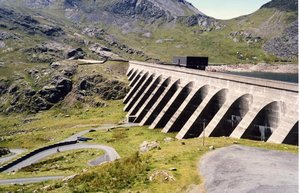Pumped-storage hydroelectricity
|
|
Pumpstor_racoon_mtn.jpg
Pumped storage hydroelectricity is a method of storing and producing electricity to supply high peak demands by moving water between reservoirs at different elevations.
| Contents |
Overview
At times of low electrical demand, excess electrical capacity is used to pump water into the higher reservoir. When there is higher demand, water is released back into the lower reservoir through a turbine, generating hydroelectricity. Reversible turbine/generator assemblies act as pump and turbine (usually a francis turbine design). Between 70% and 85% of the electrical energy used to pump the water into the elevated reservoir can be regained in this process. Some facilities use abandoned mines as the lower reservoir, but many use the height difference between two natural bodies of water or artificial reservoirs.
This system is economical as it flattens out the variations in the load on the power grid, permitting thermal power stations such as coal-fired plants and nuclear power plants that provide base-load electricity to continue operating at their most efficient capacity, while reducing the need to build special power plants which run only at peak demand times using more costly generation methods.
As well as energy management, pumped storage systems are important components in controlling electrical network frequency and in provision of reserve generation. Thermal plants are much less able to respond to sudden changes in electrical demand, which cause frequency and voltage instability. Pumped storage plants, in common with other hydroelectric plants, can respond to these changes within seconds.
The first use of pumped storage was in the 1890s in Italy and Switzerland. In the 1930s reversible hydroelectric turbines became available. These turbines could operate as both turbine-generators and in reverse as electric motor driven pumps. The latest in large-scale engineering technology are variable speed machines for greater efficiency. These machines generate in synchronisation with the network frequency, but operate asynchronously (independent of the network frequency) as motor-pumps.
A new concept is wind-pumped water storage where vagaries in wind power can be leveled by using the wind power to fill a reservoir and generating grid power from the reservoir turbines.
In 2000 the United States had 19500 MWe capacity of pumped storage. This produced a net -5500 MWe of power because they consume more power filling their reservoirs than they generate by emptying them. Still the technique is considered a worthwhile addition to the electrical grid as the most cost effective means to date for storage of mass amounts of electrical power.
In 1999 the EU had 32 GW capacity of pumped storage out of a total of 188 GW of hydropower and representing 5.5% of total electrical capacity in the EU.
Worldwide list of pumped storage plants
Australia
- Bendeela, 80 MW
- Jindabyne Pumping Station
- Kangaroo Valley, 160 MW
- Tumut Three, (1973), 1,500 MW
- Wivenhoe Power Station, 500 MW
Canada
- Sir Adam Beck Pump Generating Station, (1957) near Niagara Falls, reversible Deriaz turbines, 174 MW
China
- Guangzhou, (2000), 2,400 MW
- Tianhuangping (2001), 1,800 MW [1] (http://www.power-technology.com/projects/tianhuangping/)
Czech Republic
- Dlouhé Stráně, (1996), 650 MW
- Dalešice, (1978), 450 MW
Germany
- Goldisthal (2002)1,060 MW
- Markersbach (1981), 1,050 MW
Ireland
- Turlough Hill 292 MW
Italy
- Piastra Edolo (1982), 1,020 MW
- Chiotas (1981), 1,184 MW
- Presenzano (1992), 1,000 MW
- Lago Delio (1971), 1,040 MW
France
- Grand Maison (1997), 1,070 MW
- La Coche, 285 MW
- Le Cheylas, 485 MW
- Mortézic, 920 MW
- Revin, 800 MW
- Super Bissorte, 720 MW
Japan
- Imaichi (1991), 1,050 MW
- Kannagawa (2005), 2,700 MW is under construction. When completed in 2005, it will be the world's largest pumped storage plant.
- Kazunogawa (2001), 1,600 MW
- Kisenyama, 466 MW
- Matanoagawa (1999), 1,200 MW
- Midono, 122 MW
- Niikappu, 200 MW
- Okawachi (1995), 1,280 MW
- Okutataragi (1998), 1,932 MW
- Okuyoshino, 1,206 MW
- Shin-Takasegawa, 1,280 MW
- Shiobara, 900 MW
- Takami, 200 MW
- Tamahara (1986), 1,200 MW
- Yagisawa, 240 MW
- Yanbaru (1999), 30 MW is the first seawater pumped hydro plant.
Poland
- Żarnowiec, 716 MW
- Porąbka-Żar, 500 MW
- Solina, 200 MW
- Żydowo, 150 MW
- Niedzica, 92.6 MW
- Dychów, 79.5 MW
Russia
South Africa
- Drakensberg 1,000 MW
Taiwan
United Kingdom
- Ben Cruachan, Scotland (1965), 440 MW
- Dinorwig, Wales (1984), 1320 MW
- Ffestiniog, Wales (1963), 360 MW
- Foyers, Scotland (1975), 305 MW
United States
- Blenheim-Gilboa, NY (1973), 1,200 MW
- Castaic, CA (1978), 1,566 MW
- Clarence Cannon, MO (1983), 58 MW
- Edward C Hyatt, CA (1968), 780 MW
- Gianelli, CA (1968), 400 MW
- Helms, CA (1984), 1,200 MW
- Iowa Hill, [Placerville|CA]] (Proposed 2010), 400 MW [2] (http://hydrorelicensing.smud.org/docs/docs_iowa.htm)
- John S. Eastwood, CA (1988), 200 MW
- Lewiston (Niagara), NY (1961), 2,880 MW
- Ludington, MI (1973), 1,872 MW
- Mount Elbert, 200 MW, 1,212 MW
- Mt. Hope, 2,000 MW
- Raccoon Mountain, TN (1979), 1,530 MW
- Summit Pumped Water Plant, 1500 MW
- Taum Sauk, MO, 450 MW
- Bath County, VA, 420 MW
Other
- Kruonis Pumped Storage Plant, Lithuania (1993) Designed - 1,600 MW, installed - 900 MW
- Kühtai, Austria, 250 MW
- Kraftwerksgruppe Fragant, Austria, 100 MW
- Siah Bisheh, Iran, (1996), 1,140 MW
- Rance River, St. Malo, France 240 MW hybrid pumped water-tidal plant
- Drakensberg Pumped Storage Scheme, South Africa, (1983) 1,000 MW.
- Juktan, Sweden
Salt water (ocean)
- Kunigami Village, Okinawa, Japan [3] (http://www.jcold.or.jp/Eng/Seawater/Seawater.htm)[4] (http://www.hitachi.com/rev/1998/revoct98/r4_108.pdf)
- Koko Crater, Oahu, Hawaii [5] (http://www.hawaii.gov/dbedt/ert/pshpps/pshpps.html) (Proposed)
See also
Wikipedia_Energy_Directory_network_icon_95pxw.jpg
Wikipedia Energy Directory
- Energy directory compiles various energy technologies and issues featured at Wikipedia, with emphasis on clean, renewable energy systems.
- Hydroelectricity
- Hydropower
- Underground power station
- Turbine
- Water turbine
- Francis turbine
- Kaplan turbine
- Grid energy storage
External links
- Excellent technical article from ASME about the Hiwassee pumped storage turbines and generators (http://www.asme.org/history/brochures/H067.pdf)de:Pumpspeicherkraftwerk

